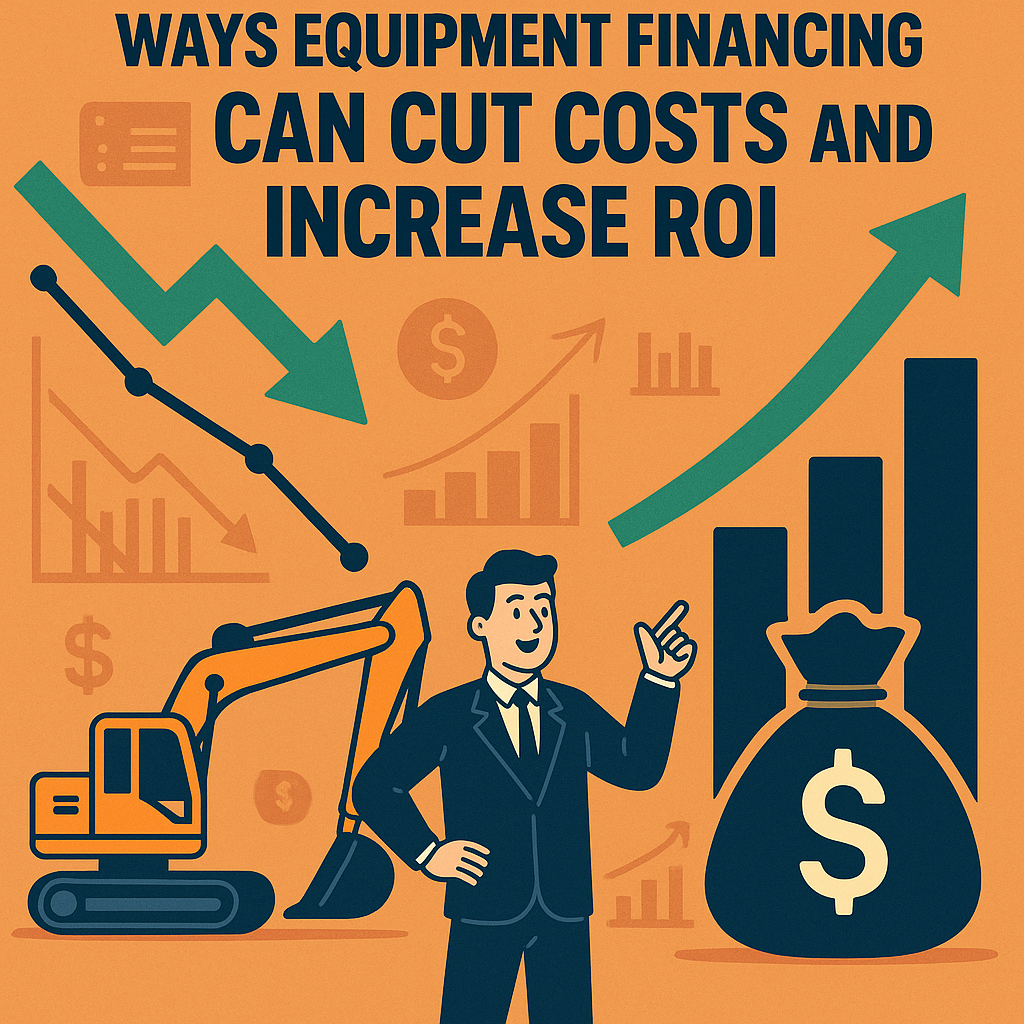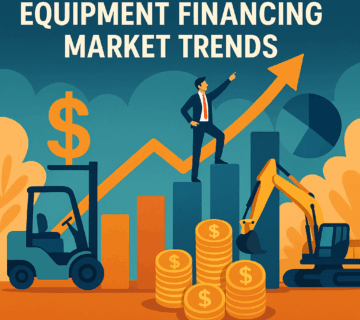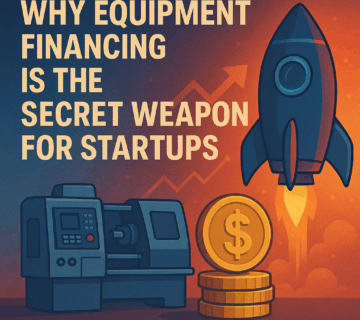Equipment Financing in 2025: The Smartest Way to Grow Without Breaking Cash Flow

In today’s economy, businesses face a constant challenge: balancing growth with financial stability. Whether you’re running a construction company, a healthcare clinic, a restaurant, or a logistics firm, one truth remains the same having the right equipment is essential.
But purchasing high-value machinery, medical devices, or IT systems requires significant capital. For small and medium-sized businesses (SMBs), this often means dipping into working capital that could otherwise fund payroll, marketing, or product development.
That’s why equipment financing has become a vital solution in 2025. Instead of depleting cash reserves, companies can spread equipment costs over time, maintain liquidity, and keep operations running smoothly.
In this in-depth blog, we’ll cover:
- What equipment financing is and how it works
- Why businesses in 2025 are turning to financing more than ever
- The biggest benefits of financing equipment
- Different financing structures and which one fits best
- Industries that gain the most from equipment financing
- Trends shaping the market this year
- Tips to qualify for the best terms
- Mistakes businesses should avoid
- A complete FAQ section for common queries
What Is Equipment Financing?
Equipment financing is a financial arrangement that helps businesses purchase or lease equipment without paying the full cost upfront. The lender or leasing company covers the purchase, and you repay over time through fixed monthly installments.
This type of financing can be used for:
- Construction machinery
- Manufacturing tools
- Restaurant equipment
- Medical and dental devices
- IT hardware and software
- Commercial vehicles
In most cases, the equipment itself serves as collateral, which reduces the risk for lenders and makes approval easier than with unsecured loans.
How Equipment Financing Works in 2025
Thanks to fintech advancements, the process is now faster and more transparent:
- Identify the equipment you need.
- Apply with a lender—either a traditional bank, credit union, or online financing platform.
- Get fast approval—AI-driven credit assessments can provide decisions within hours.
- Purchase & delivery—the lender pays the vendor, and you start using the equipment immediately.
- Repayment—fixed monthly payments over the loan or lease term.
Benefits of Equipment Financing
1. Preserves Working Capital
Instead of locking money into equipment, you can keep funds available for growth strategies, emergencies, or daily operations.
2. Access to the Latest Technology
Financing allows businesses to upgrade equipment regularly, staying ahead of competitors without huge upfront costs.
3. Tax Advantages
Under Section 179 of the U.S. tax code, many equipment purchases are deductible, providing major savings. Leasing payments can also qualify as business expenses.
4. Flexible Structures
Choose between loans, leases, or hybrid financing models depending on your business goals.
5. Easier Approval
Since the equipment itself is collateral, businesses with limited credit history can often qualify more easily.
Types of Equipment Financing
1. Equipment Loans
You borrow money to purchase the equipment and own it once the loan is paid off.
2. Equipment Leasing
Rent equipment for a fixed period. Options include:
- Operating lease: Short-term, lower payments, no ownership.
- Capital lease: Functions more like a loan, with the option to own the equipment at the end.
3. Vendor Financing
Manufacturers and suppliers offer financing directly, bundling the purchase and repayment in one agreement.
4. Sale-Leaseback
Sell equipment you already own to a financing company and lease it back. This frees up capital while keeping operations intact.
5. SBA Loans
Small Business Administration loans provide low-interest, long-term financing, especially attractive for SMBs.
Industries That Benefit Most
- Construction: Bulldozers, cranes, and heavy machinery.
- Healthcare: Imaging systems, lab tools, and surgical devices.
- Restaurants: Ovens, refrigerators, and POS systems.
- Manufacturing: Robotics, 3D printers, and conveyor systems.
- Technology: Servers, software, and IT infrastructure.
- Transportation: Trucks, vans, and fleet upgrades.
Trends in Equipment Financing (2025)
1. Digital Lending Platforms
AI-driven approvals allow businesses to access financing in as little as 24 hours.
2. Subscription Models
“Equipment as a Service” (EaaS) is booming—especially for IT and medical devices. Businesses pay monthly fees that include upgrades and maintenance.
3. Green Financing Incentives
Eco-friendly machinery is not only good for the planet but also comes with better financing terms and government incentives.
4. Hybrid Lease-to-Own Options
These flexible agreements combine the benefits of leasing with eventual ownership rights.
5. ERP Integration
Modern financing systems now link with ERP and accounting tools, providing real-time visibility into asset management and payments.
How to Qualify for Equipment Financing
Most lenders evaluate:
- Credit score (both business and personal)
- Time in business (2+ years preferred)
- Annual revenue and cash flow
- Equipment type and resale value
Tips to Secure the Best Financing Terms
- Compare lenders for rates, fees, and terms.
- Check the total cost, including interest and maintenance.
- Leverage tax deductions to reduce net expenses.
- Negotiate terms aligned with your revenue cycle.
- Plan for end-of-term—decide whether to return, upgrade, or buy equipment.
Mistakes to Avoid
- Over-financing equipment you don’t need.
- Ignoring depreciation when choosing between leasing and owning.
- Accepting the first lender’s offer without comparing options.
- Skipping fine-print details like hidden fees or prepayment penalties.
Future Outlook
By 2025 and beyond, expect:
- More eco-friendly financing packages.
- Blockchain-based contracts for transparency.
- Increased adoption of pay-per-use billing models.
- Closer vendor-lender partnerships to streamline financing.
Frequently Asked Questions (FAQ)
1. What credit score is needed for equipment financing?
Most lenders prefer a score of 650+, but since the equipment itself is collateral, some lenders accept lower scores.
2. Is it better to lease or buy equipment?
It depends. If you need frequent upgrades, leasing is ideal. If you plan to use the equipment long-term, buying through a loan may save money.
3. Can startups get equipment financing?
Yes, but they may need to provide a down payment, personal guarantee, or strong business plan to qualify.
4. What types of equipment can be financed?
Almost any business equipment—construction, medical, IT, restaurant, manufacturing, or vehicles—can be financed.
5. Are equipment lease payments tax deductible?
Yes, in many cases lease payments qualify as deductible business expenses. Always consult a tax advisor.
6. How long are equipment financing terms?
Typically between 12 months and 10 years, depending on equipment type and lender.
7. Can I finance used equipment?
Yes. Many lenders finance used equipment, though interest rates may be slightly higher.
8. What happens at the end of a lease?
You can usually choose to return the equipment, upgrade to newer models, or purchase it at fair market value.
9. Is equipment financing only for large businesses?
Not at all. Small businesses and startups benefit most because financing helps preserve working capital.
10. How fast can I get approved?
With online platforms, approvals can happen in 24–48 hours. Traditional banks may take longer.
Conclusion
In 2025, equipment financing is more than just a funding option—it’s a smart strategy that helps businesses stay competitive, flexible, and profitable. By spreading costs over time, preserving cash flow, and gaining access to the latest technology, companies across industries can grow without financial strain.




No comment